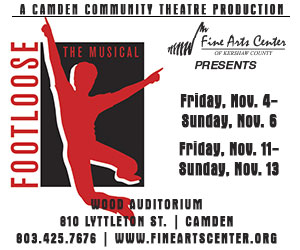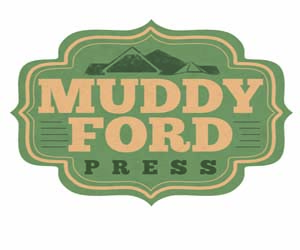Design and Process with Clark Ellefson
By Kristine Hartvigsen
Clark Ellefson has an idea − but instead of the figurative light bulb hovering over his head, imagine one of the artist’s glowing tin perforated Incredible Hulk lunchboxes instead. Or how about a charming postmodern “Mini Mojo” lamp with and artisanal paper shade. Ellefson is full of ideas, in fact, and you can bet there’s a unique fixture shedding light on every one of them.
It’s not unusual to spot Ellefson making elaborate architectural-style “doodles” on a cocktail napkin while perched at the otherworldly, textured steel island that anchors the Art Bar, a popular Vista nightspot he opened in 1992. The bar’s distinctive furniture and eclectic fixtures are of Ellefson’s design and likewise could have been conceived on a paper napkin. Even when he’s relaxing, his mind is always engaged. “I like to think about stuff a lot,” he says. “If I only have a piece of paper and a pencil, I can entertain myself for hours designing and redesigning things. I am not idle.”
A longtime Columbian, Ellefson earned a BFA, with an emphasis in sculpture, ceramics, and film, from the University of South Carolina in 1974. Early on, he did carpentry work to support his budding sculpture career. This skill set quite naturally led to designing and making furniture. “I got into furniture-making because the post-modern movement was hitting,” he says, adding that he was particularly taken with the work coming out of the Memphis Design Group, a school of Italian designers and architects that produced pop art-inspired, modern art furniture that literally broke the mold in the mid-1980s.. A hallmark of Memphis design is the use of unconventional materials, including sheet metal or plastic, and unexpected colors, such as Candyland pink or Miami aqua. Brand consultant Bertrand Pellegrin, in a January 15, 2012, San Francisco Chronicle article, aptly described the Memphis design movement, which is experiencing a resurgence in popularity, as “a shotgun wedding between Bauhaus and Fischer-Price.” It’s about breaking the rules to stunning effect. Like Ellefson himself.
Yet Ellefson’s design vision far transcends the original home décor and lighting products he crafts today as owner and principal designer of Lewis+Clark Gallery. For decades, he has envisioned transformative growth in Columbia. He is widely recognized as a pioneer who, along with his business partner, the late Jim Lewis, set up shop in the mostly abandoned, run-down area west of Assembly Street in 1983, long before the Vista was a cool place to be. “At that time, it was a big risk,” Ellefson recalls. “We signed a five-year lease. We were both self-employed and living hand-to-mouth.”
The partners forged a name for themselves for several years creating contemporary, Memphis-inspired and avant garde furniture, including a signature Japanese kimono-shaped cabinet that helped put Lewis+Clark on the map. The kimono cabinet is a collector’s item now. One resides in the State Art Collection. One sits in the office of Columbia Development Corporation Executive Director Fred Delk, a good friend of Ellefson’s. And there’s even one in the upscale European headquarters of a company that invited Ellefson to attend its grand opening – in Switzerland. “I was so broke at the time,” he says. “I couldn’t go to the reception. That was a lost opportunity there.”
Fast-forward 24 years or so, after Ellefson had successfully operated a workshop in one Lincoln Street storefront and a separate gallery space down the sidewalk at the corner of Lincoln and Lady Streets, and Ellefson’s story takes a dramatic turn. Over those years, the Vista attracted businesses from upscale eateries, hotels, and bars to design firms and more art galleries, making the district a chic destination for the Midlands. Ellefson led much of that growth, masterminding the twice annual gallery crawl in the Vista, known as Artista Vista in the spring and Vista Lights in the fall. But all that prosperity came at a cost. While he owned his workshop space, the gallery was leased, and the owner had big money-making plans that didn’t include beatnik artists. He raised the rent far beyond what was affordable for Ellefson, who was forced out in 2007, just as the recession was taking hold.
“It was a huge tragedy for me,” Ellefson says. “He was a douche bag developer. … But I have always suffered the woes of leasing space and being turned out. I have always felt that if you can own your space, it is really better for your career. Artists often go into derelict neighborhoods, improve the place, create demand for it, improve property values, and then get pushed out.”
Ellefson may have been down, but he was far from out. He got together with Harriett Green, visual arts director for the SC Arts Commission, and the two brainstormed the idea of finding empty old warehouses and putting studio spaces in them. They found, however, that Columbia doesn’t actually have that many old buildings available. The two conducted a survey of what artists wanted, and most respondents overwhelmingly wanted to be in the city and, particularly, in the Vista. When Ellefson tried to interest enough artists to go in together to purchase a building, it did not work out. Enter Fred Delk, the above-mentioned proud keeper of Ellefson’s kimono cabinet. Delk wanted to help and was in a position to do just that.
“Fred said to me, ‘I have an idea,’” Ellefson recalled. The city had acquired a property that backs up near the Congaree River on the 1000 block of Huger Street as a possible location for the new Columbia Museum of Art. The museum, however, ended up locating downtown at the corner of Main and Hampton streets, so the Huger Street property was just sitting there. It had a building on it that once housed an appliance parts company, and it was available. “I talked to the owners of One-Eared Cow (an art glass blowing studio also on Huger), and we formed a corporation that we called ‘Appliance Arts Company.’”
Ellefson and One-Eared Cow owners Mark Woodham and Tommy Lockart (as Appliance Arts Company) purchased part of the property, with One-Eared Cow moving into the existing street-front building. “We agreed early on that they could have the front of the building because their business depends so much on retail,” Ellefson says. “Most of my sales are out of state.”
Ellefson built onto the original building, adding 6,000 square feet that includes meeting space to receive visitors and help pitch a new idea − the Columbia Art Studio Project, or CASP (also dubbed “Stormwater Studios”). CASP is a pocket art colony envisioned for the approximately 1.5 acres next to the Appliance Art Company property. The land is overgrown with weeds and doesn’t look like much right now, but Ellefson and others can see its potential. The Columbia Development Corporation, along with the Columbia Design League, the SC Arts Commission, and the City of Columbia organized a two-day design charrette in the summer of 2007 to gather input from members of the local arts community regarding the planning, design, and ownership structure of art studios and live/work units being proposed for the tract. Their intent remains for the project eventually to operate sustainably, without ongoing public subsidies.
Charrette participants heard a series of reports, including the Innovista Master Plan, which conceivably could connect with CASP and the State Museum via common outdoor, pedestrian-friendly areas along the riverfront, including parks and public art spaces. Participants overwhelmingly supported use of environmentally sensitive design methods in what they conceived to be a complex of three two-story buildings with living spaces above and studio bays below. Sketches included the possibility of dramatic structural overhangs to provide shade and accommodate indoor/outdoor areas for artists to create and display their work.
“The focus is on a pure studio building first, then split it up into bays, and artists can purchase a bay,” Ellefson explains. “Each bay would be 600-800 square feet. For a lot of people, that is a lot of space. There would be covenants to ensure that the space is always used as an art space.”
Progress has been slow since then, primarily, Ellefson says, because it’s self-funded. He hopes to organize an event, perhaps a cookout, on the site and invite interested artists to discuss affordable pricing schemes for the units and what needs to happen to move CASP forward. Because the Columbia Development Corporation owns the land, it has the ability to persuade the bank to “write down,” or reduce, the land value to its true market value, which also would reduce the taxable net income of the project. That still would leave a gap in funding, but foundation grants and donations are also possible. Overall, there is strong desire for CASP units to be owned by artists rather than rented.
Ellefson, in the meantime, is taking the live/work concept to heart. He’s single-handedly building an unobtrusive one-bedroom, loft-style residence just across from the entrance to his Huger Street studio. When completed, it promises to be a showplace of sexy postmodern craftsmanship, from its hand-hewn kitchen cabinets to its inlaid wood floors stained in multiple contrasting colors and the slanting staircase with decorative accents hand-cut into the wood. He cleverly installed a roll-top glass garage door so his living room can open directly to the outdoors. It will be classic Ellefson. “I have a lot of artwork stowed away. The house will be full of art, that is for sure,” he says. “It will be bohemian, modern, and deliberately eclectic.”
With all these projects operating in a perpetual state of flux, Ellefson also contemplates new directions for his professional career, which has been relegated somewhat to the back-burner. Like clockwork, the proverbial light bulb continues to appear. “I am anxious to get back to my career full-time,” he says. “There are some really interesting opportunities in lighting now. When I think about what I want to make or design, it is related to lighting. It’s a product that is a little easier to market than furniture.”
Ellefson’s high-end art lamps crafted with specialty art paper shades, steel, and hand-finished wood bases (see lewisandclarklamps.com and artfulhome.com), already are steady sellers. And the funky robot-inspired lamps and re-crafted metal objets d’art on display at Ellefson’s Lincoln Street workshop always draw an appreciative crowd. “I’m just having some fun with that,” he insists. “It’s not big money for me.” But he would like to expand his lighting products to much larger markets.
In fact, Ellefson wants to move away from pricey custom work. He still enjoys making things, but he says he would like to explore designing for a manufacturer that could accommodate broad production of decent quality, artistically edgy items attainable by average consumers. “Everyone wants a certain look,” he says. “Very few of us can afford what we truly want.” With luck, Ellefson will narrow that affordability margin – both for artists and those who purchase their work.






.jpg)
